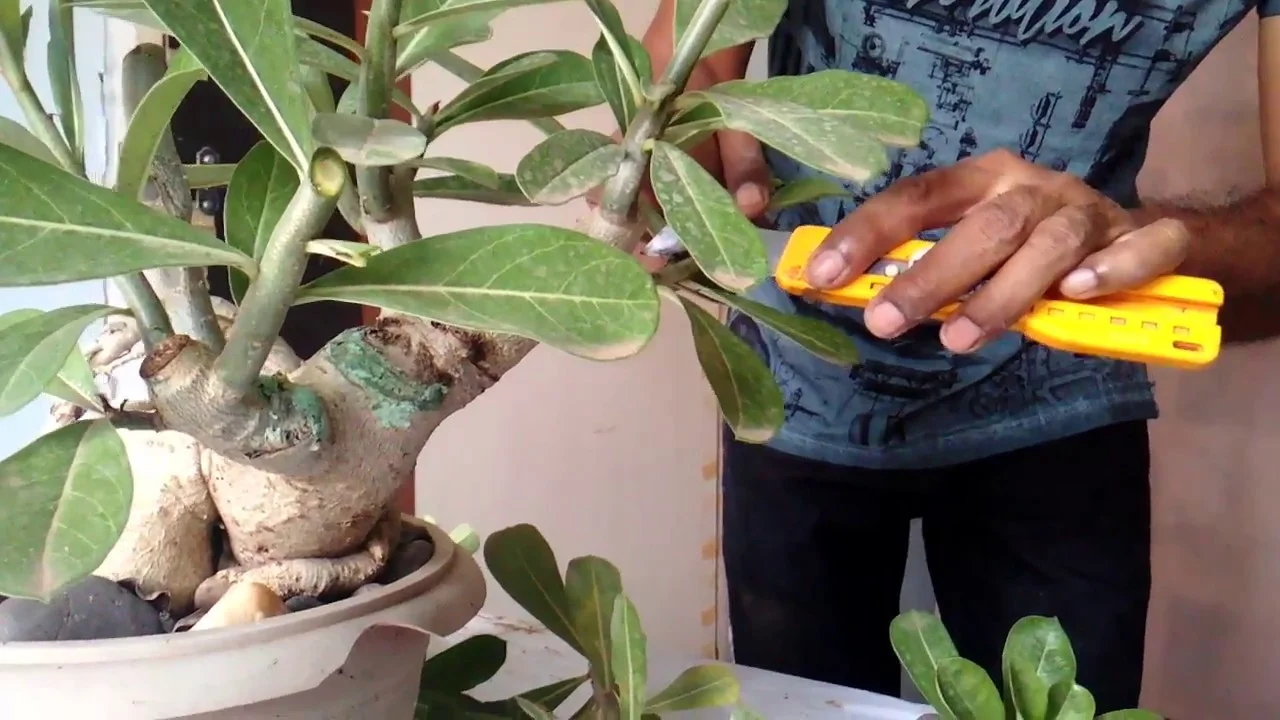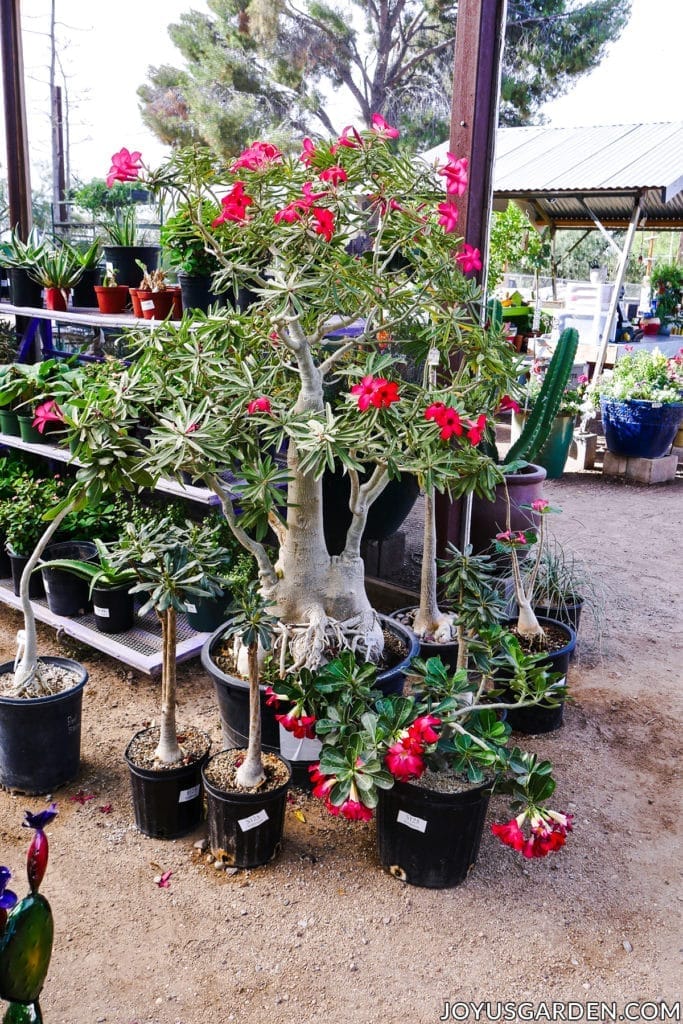How to Trim My Adenium Desert Rose Plant

If you have an adenium desert rose plant that is getting too big, you may need to trim it. Trimming an adenium is not difficult, but there are a few things you need to keep in mind. Here are some tips on how to trim your adenium desert rose plant:
First, you will need to decide where you want to make your cuts. It is best to make your cuts at least 6 inches above the soil line. This will help ensure that your plant has enough leaves and stems remaining to continue growing.
Next, use a sharp knife or pruning shears to make clean, precise cuts. Avoid tearing or crushing the stems as this can damage the plant.
Finally, water your plant well after trimming and fertilize it if necessary.
With proper care, your adenium desert rose plant will soon be looking its best!
- Using sharp, clean shears or a knife, cut off any dead or dying leaves, stems, and blooms
- Trim back any long or leggy branches to encourage compact growth
- Remove any suckers that are growing from the base of the plant
- Shape the plant as desired, making sure to leave enough leaves on each branch for the plant to continue to photosynthesize and produce energy

Credit: www.joyusgarden.com
When Should You Trim a Desert Rose?
When to Trim a Desert Rose?
Desert roses are beautiful, low-maintenance plants that add color and life to any home. While they don’t require much in the way of care, they do need to be trimmed on occasion.
But when is the best time to trim a desert rose?
The answer may surprise you – there is no one perfect time to trim a desert rose. In fact, you can actually trim them any time of year!
However, there are a few things to keep in mind when doing so.
For starters, it’s important not to trim too much off at once. This can shock the plant and cause it to go into survival mode, which isn’t good for its health.
It’s better to make several small trims over the course of a few months than one big one.
Another thing to consider is the plant’s growth cycle. If you want your desert rose to bloom abundantly, it’s best to trim it after it has finished blooming for the season.
This will encourage new growth and more flowers next season. However, if you’re not concerned with abundant blooms, you can trim anytime – just be sure not to remove more than 1/3 of the plant at a time.
Lastly, pay attention to the weather before you trim your desert rose.
If it’s been particularly hot or dry out recently, hold off on trimming until conditions improve.
What Month Should You Trim Adenium?
If you want to keep your Adenium looking its best, you should trim it once a month. This will help to keep the plant full and bushy, and will also prevent it from getting too leggy.
How Far Back Can You Prune a Desert Rose?
Desert roses are a type of rose that is known for its ability to thrive in hot, dry climates. They are native to the deserts of North Africa and the Arabian Peninsula, but can also be found in other arid regions around the world.
Desert roses are tough plants that can tolerate being pruned quite severely.
In fact, they often require heavy pruning in order to keep them from becoming too large or unruly. However, there is a limit to how far back you can prune a desert rose without damaging it.
Ideally, you should only prune desert roses back by about one-third their total height.
Pruning any more than this can shock the plant and cause dieback or even death. So, if you have a desert rose that is getting too big for its space, be sure to only remove one-third of its height when you prune it back.
How Do You Trim a Desert Plant?
If you want to trim a desert plant, the best time to do it is in the spring. This will give the plant time to recover from any damage that was done during the winter. You should also wait until the plant is actively growing.
To trim a desert plant, start by removing any dead or dying leaves or stems. Cut back any branches that are crossing over each other or rubbing against each other. Next, prune off any branches that are growing in an undesirable direction.
Finally, shape the plant by cutting back any longer branches.
Be sure to use sharp pruning shears and make clean cuts. If possible, try to avoid wounding the plant too much as this can invite pests and diseases.
When you’re finished trimming, water your desert plant well and give it some extra TLC while it recovers from its haircut!
DESERT ROSE (ADENIUM) PRUNING / JoyUsgarden
Best Time to Prune Desert Rose
Desert roses are a beautiful and popular plant, but they can be a bit finicky when it comes to pruning. The best time to prune your desert rose is in the late winter or early spring, before new growth begins. This will give the plant time to heal and recover from any cuts before the hot summer months begin.
When pruning, be sure to remove any dead or dying branches first. Cut these back to just above where they meet a healthy branch or stem. Next, trim away any branches that are crossing or rubbing against each other.
These can create wounds that will invite pests and diseases into the plant. Finally, cut back any long or leggy stems to encourage bushier growth.
As with all plants, it’s important not to remove more than about one-third of the total growth at one time.
This will help prevent shock and ensure that your desert rose continues to thrive for years to come!
Pruning Sealer for Desert Rose
If you have a desert rose plant, you may be wondering if you need to use a pruning sealer. The answer is yes! A pruning sealer helps to prevent moisture loss and seals in the plant’s natural oils.
It also helps to protect the plant from disease and pests.
How to Prune a Desert Rose Plant Video
Desert rose plants are a beautiful addition to any landscape, but they can be a bit of a challenge to keep looking their best. Pruning is a essential part of keeping your desert rose plant healthy and happy. In this video, we’ll show you how to properly prune your desert rose plant.
First, you’ll want to remove any dead or dying branches. Cut these back to the main stem of the plant. Next, take a look at the remaining branches and determine which ones are crossing or rubbing against each other.
These should also be trimmed back to the main stem.
Now it’s time to focus on shaping the plant. Trim back any long or leggy branches so that the overall shape of the plant is more compact and uniform.
You can also trim off any spent flowers or seed pods that remain on the plant.
Pruning may seem like a lot of work, but it’s really important for the health and appearance of your desert rose plant!
Can I Propagate My Adenium Desert Rose Plant by Trimming it?
Trimming is a helpful tool for desert rose plant propagation techniques. By carefully cutting off the top growth, you can encourage your Adenium plant to branch out, resulting in multiple stems. These trimmed parts are perfect for propagating; simply plant them in well-draining soil, and they may grow into new plants.
Hard Prune Desert Rose
Desert Rose (Adenium obesum) is a beautiful and popular flowering plant that originates from Africa. It is known for its stunning flowers that come in a variety of colors, including pink, red, white, and yellow. The plant can reach up to six feet tall and has a thick trunk with fleshy leaves.
Desert Rose is not frost-tolerant and should be protected from cold weather.
In order to keep your Desert Rose healthy and encourage blooming, it is important to prune the plant regularly. Hard pruning is necessary every few years to remove old growth and stimulate new growth.
This will also help to keep the plant compact and prevent it from getting too leggy.
To hard prune your Desert Rose, start by cutting back all of the stems by about one-third their length. Next, thin out the foliage so that there are only a few leaves left on each stem.
Finally, cut off any dead or damaged branches. Once you have finished pruning, your Desert Rose will need some time to recover before it begins blooming again. Be patient and give it the care it needs during this time – with proper care, your plant will soon reward you with an abundance of beautiful flowers!
Conclusion
If you have an adenium desert rose plant that is getting too big, you can trim it back to size. First, find a place where you can do the trimming without damaging the plant. Second, cut off any dead or dying branches.
Third, cut back the branches that are longer than the others. Fourth, prune any branch that is crossing another branch. Fifth, remove any suckers that are growing from the base of the plant.
Sixth, fertilize the plant after trimming to help it recover.
